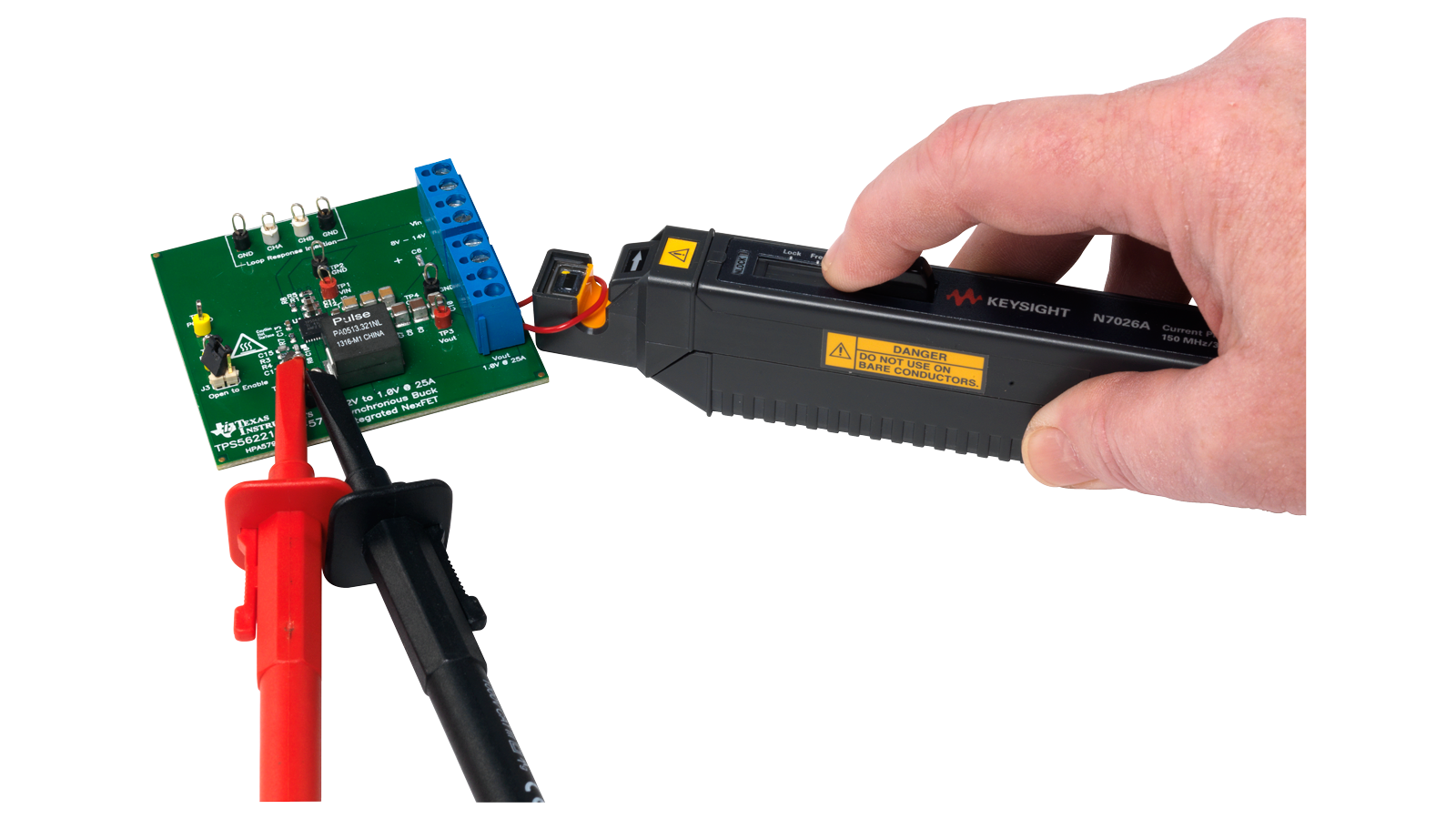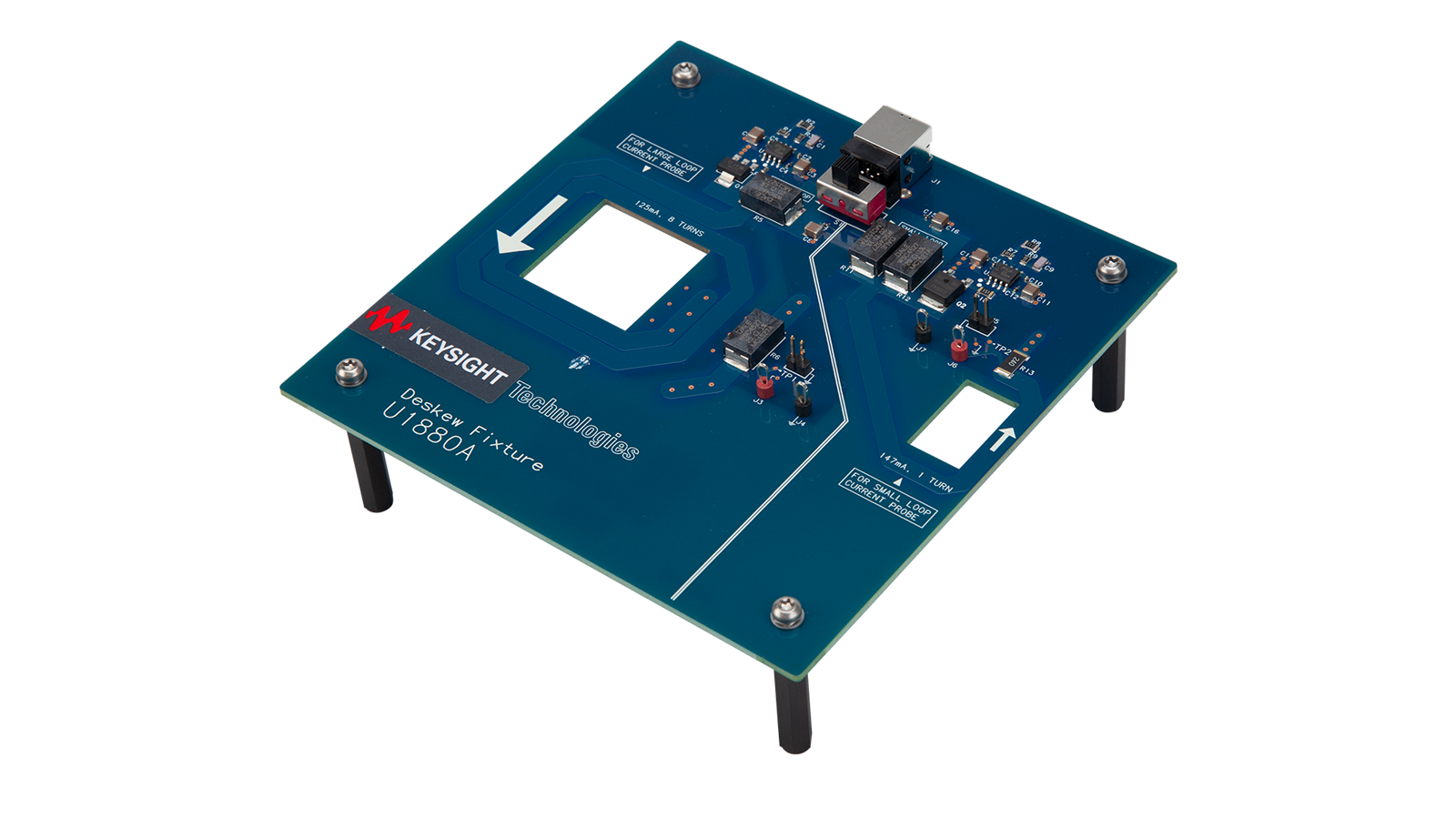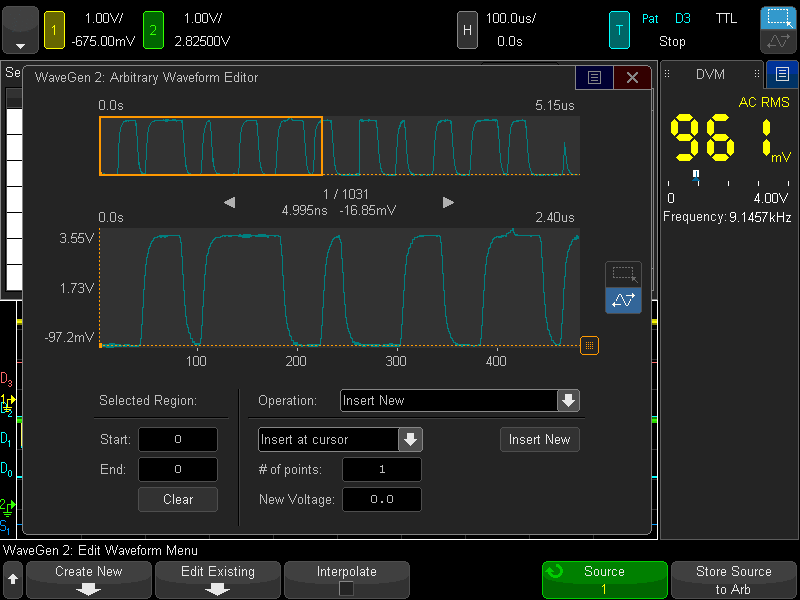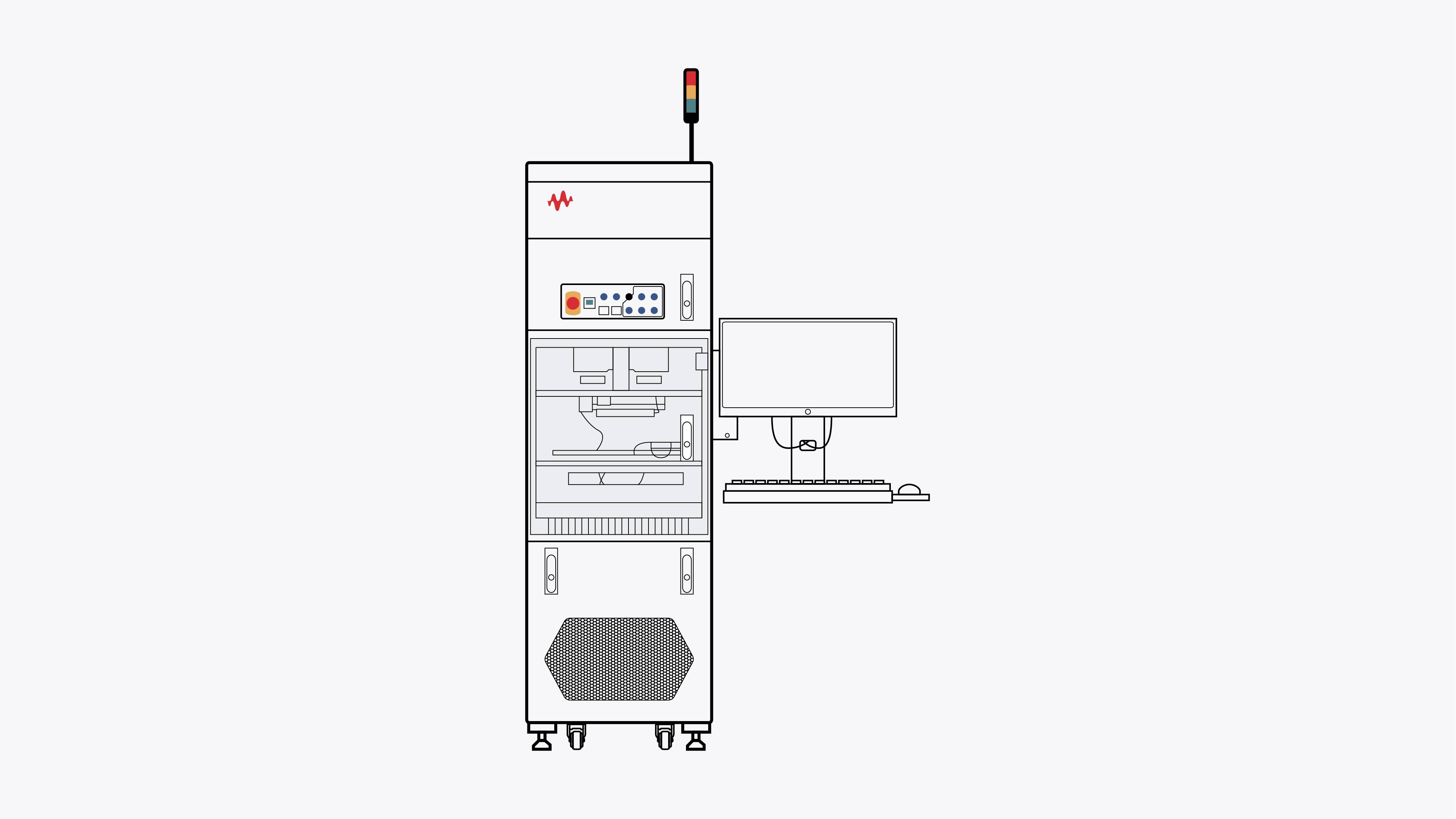How to Test Switch-Mode Power Supplies


Characterizing switch-mode power supplies with an oscilloscope
Characterizing the operation of switch-mode power supplies requires a broad range of measurements using an oscilloscope. You must analyze the power supply's input, switching, and output. You will also need to make frequency response measurements like power supply rejection ratio (PSRR) and control loop response. These measurements are typically made with a vector network analyzer (VNA).
Perform these measurements using an oscilloscope with power measurement software, a deskew fixture, a high-voltage differential probe, a current probe, and a passive voltage probe. The deskew fixture nulls the difference in propagation delay between the probes for more accurate measurements. Deskewing is critical for the switching loss measurement. Time delay can cause significant differences in power and energy measurements during the turn-on and turn-off phases of transistor switching.

Switch-mode power supply characterization solution
See demo of switch-mode power supply characterization
Explore products for our switch-mode power supply characterization solution
-
![N7026A AC/DC High Sensitivity Clamp-On Current Probe]()
N7026A AC/DC High Sensitivity Clamp-On Current Probe
-
![N2790A High-Voltage Differential Probe, 100 MHz]()
N2790A High-Voltage Differential Probe, 100 MHz
-
![U1880A Power Measurement Deskew Fixture]()
U1880A Power Measurement Deskew Fixture
-
![MSOX4154A Mixed Signal Oscilloscope: 1.5 GHz, 4 Analog Plus 16 Digital Channels]()
MSOX4154A Mixed Signal Oscilloscope: 1.5 GHz, 4 Analog Plus 16 Digital Channels
-
![D4000BDLB Ultimate Software Bundle for the 4000 X-Series]()
D4000BDLB Ultimate Software Bundle for the 4000 X-Series
-
![DSOX4WAVEGEN2 WaveGen Built-in Dual-chan Function and Arbitrary Waveform Generator for 4000 X-Series Oscilloscopes]()
DSOX4WAVEGEN2 WaveGen Built-in Dual-chan Function and Arbitrary Waveform Generator for 4000 X-Series Oscilloscopes


How to Test Switch Mode Power Supplies
N7026A AC/DC High Sensitivity Clamp-On Current Probe
Measure down to 1 mA/div, giving you a much more accurate view of low-level signals
Specs
| Type |
|


How to Test Switch Mode Power Supplies
N2790A High-Voltage Differential Probe, 100 MHz
Obtain floating signal measurements of up to 1,400 V of differential voltage and up to 1,000 V of common mode voltage
Specs
| Bandwidth | 100 MHz |
| Type |
|
| Probe Type |
|


How to Test Switch Mode Power Supplies
U1880A Power Measurement Deskew Fixture
Deskew the time delay between voltage and current probes, driving both probes with the same pulse signal
Specs
| Connector Type |
|
| Ports | |
| Type |
|
| Maximum Frequency |


How to Test Switch Mode Power Supplies
MSOX4154A Mixed Signal Oscilloscope: 1.5 GHz, 4 Analog Plus 16 Digital Channels
The 4000 X-Series boasts 12.1-inch display, capacitive touch screen technology, InfiniiScan Zone touch triggering, 1-million-waveforms/sec update rate, MegaZoom IV smart memory technology and standard segmented memory.
Specs
| Bandwidth | 1.5 GHz |
| Max memory depth | 4 Mpts |
| Max sample rate | 5 GSa/s |
| Type |
|


How to Test Switch Mode Power Supplies
D4000BDLB Ultimate Software Bundle for the 4000 X-Series
Enable all software applications on the InfiniiVision 4000 X-Series oscilloscopes
Specs
| Debug & Analysis Software |
|
| Connectivity & Usability Software |
|
| Compliance Test Applications |
|
| Select Oscilloscope Series |
|
| Software Type |
|
| Applications |
|
| Compatible Instruments |


How to Test Switch Mode Power Supplies
DSOX4WAVEGEN2 WaveGen Built-in Dual-chan Function and Arbitrary Waveform Generator for 4000 X-Series Oscilloscopes
You can use the built-in waveform editor to create custom waveforms to output on the WaveGen of the scope. You can also capture a known good or golden waveform on a scope channel and save that to the ARB and generate it through BNC output.
Specs
| Debug & Analysis Software |
|
| Connectivity & Usability Software |
|
| Compliance Test Applications | |
| Select Oscilloscope Series |
|
| Software Type |
|
| Applications |
|
| Compatible Instruments |
Discover resources and insights
Additional resources for characterizing switch-mode power supply designs
-
Datasheet
Explore InfiniiVision Oscilloscope Application Bundles
-
Datasheet
Discover our Power Software Package for InfiniiVision X-Series Oscilloscopes
-
Application note
How to Make Switch Mode Power Supply Measurements
-
Application note
Learn About Power Supply Control Loop Response (Bode Plot) Measurements
-
Datasheet
Explore InfiniiVision Oscilloscope Application Bundles
-
Datasheet
Discover our Power Software Package for InfiniiVision X-Series Oscilloscopes
-
Application note
How to Make Switch Mode Power Supply Measurements
-
Application note
Learn About Power Supply Control Loop Response (Bode Plot) Measurements
Related use cases
-
![How to Evaluate IV Characteristics of Solar Cells]() segmentation:business-unit/EISG,segmentation:campaign/IC_Semi_Mfg,segmentation:product-category/IC_Semi_Mfg/Semiconductor_Test,keysight:product-lines/1h,keysight:dtx/solutions/facets/development-area/power,keysight:dtx/solutions/facets/workflow-stage/functional-test,keysight:dtx/solutions/facets/industry/semiconductor,segmentation:funnel/bofu,keysight:dtx/solutions/facets/design-and-test-product/power-supply,keysight:models/b2/b2902bu,keysight:models/pw/pw9251a,segmentation:product-category/IC_Semi_Mfgsegmentation:business-unit/EISG,segmentation:campaign/IC_Semi_Mfg,segmentation:product-category/IC_Semi_Mfg/Semiconductor_Test,keysight:product-lines/1h,keysight:dtx/solutions/facets/development-area/power,keysight:dtx/solutions/facets/workflow-stage/functional-test,keysight:dtx/solutions/facets/industry/semiconductor,segmentation:funnel/bofu,keysight:dtx/solutions/facets/design-and-test-product/power-supply,keysight:models/b2/b2902bu,keysight:models/pw/pw9251a,segmentation:product-category/IC_Semi_Mfgsegmentation:business-unit/EISG,segmentation:campaign/IC_Semi_Mfg,segmentation:product-category/IC_Semi_Mfg/Semiconductor_Test,keysight:product-lines/1h,keysight:dtx/solutions/facets/development-area/power,keysight:dtx/solutions/facets/workflow-stage/functional-test,keysight:dtx/solutions/facets/industry/semiconductor,segmentation:funnel/bofu,keysight:dtx/solutions/facets/design-and-test-product/power-supply,keysight:models/b2/b2902bu,keysight:models/pw/pw9251a,segmentation:product-category/IC_Semi_Mfgsegmentation:business-unit/EISG,segmentation:campaign/IC_Semi_Mfg,segmentation:product-category/IC_Semi_Mfg/Semiconductor_Test,keysight:product-lines/1h,keysight:dtx/solutions/facets/development-area/power,keysight:dtx/solutions/facets/workflow-stage/functional-test,keysight:dtx/solutions/facets/industry/semiconductor,segmentation:funnel/bofu,keysight:dtx/solutions/facets/design-and-test-product/power-supply,keysight:models/b2/b2902bu,keysight:models/pw/pw9251a,segmentation:product-category/IC_Semi_Mfgsegmentation:business-unit/EISG,segmentation:campaign/IC_Semi_Mfg,segmentation:product-category/IC_Semi_Mfg/Semiconductor_Test,keysight:product-lines/1h,keysight:dtx/solutions/facets/development-area/power,keysight:dtx/solutions/facets/workflow-stage/functional-test,keysight:dtx/solutions/facets/industry/semiconductor,segmentation:funnel/bofu,keysight:dtx/solutions/facets/design-and-test-product/power-supply,keysight:models/b2/b2902bu,keysight:models/pw/pw9251a,segmentation:product-category/IC_Semi_Mfgsegmentation:business-unit/EISG,segmentation:campaign/IC_Semi_Mfg,segmentation:product-category/IC_Semi_Mfg/Semiconductor_Test,keysight:product-lines/1h,keysight:dtx/solutions/facets/development-area/power,keysight:dtx/solutions/facets/workflow-stage/functional-test,keysight:dtx/solutions/facets/industry/semiconductor,segmentation:funnel/bofu,keysight:dtx/solutions/facets/design-and-test-product/power-supply,keysight:models/b2/b2902bu,keysight:models/pw/pw9251a,segmentation:product-category/IC_Semi_Mfgsegmentation:business-unit/EISG,segmentation:campaign/IC_Semi_Mfg,segmentation:product-category/IC_Semi_Mfg/Semiconductor_Test,keysight:product-lines/1h,keysight:dtx/solutions/facets/development-area/power,keysight:dtx/solutions/facets/workflow-stage/functional-test,keysight:dtx/solutions/facets/industry/semiconductor,segmentation:funnel/bofu,keysight:dtx/solutions/facets/design-and-test-product/power-supply,keysight:models/b2/b2902bu,keysight:models/pw/pw9251a,segmentation:product-category/IC_Semi_Mfgsegmentation:business-unit/EISG,segmentation:campaign/IC_Semi_Mfg,segmentation:product-category/IC_Semi_Mfg/Semiconductor_Test,keysight:product-lines/1h,keysight:dtx/solutions/facets/development-area/power,keysight:dtx/solutions/facets/workflow-stage/functional-test,keysight:dtx/solutions/facets/industry/semiconductor,segmentation:funnel/bofu,keysight:dtx/solutions/facets/design-and-test-product/power-supply,keysight:models/b2/b2902bu,keysight:models/pw/pw9251a,segmentation:product-category/IC_Semi_Mfgsegmentation:business-unit/EISG,segmentation:campaign/IC_Semi_Mfg,segmentation:product-category/IC_Semi_Mfg/Semiconductor_Test,keysight:product-lines/1h,keysight:dtx/solutions/facets/development-area/power,keysight:dtx/solutions/facets/workflow-stage/functional-test,keysight:dtx/solutions/facets/industry/semiconductor,segmentation:funnel/bofu,keysight:dtx/solutions/facets/design-and-test-product/power-supply,keysight:models/b2/b2902bu,keysight:models/pw/pw9251a,segmentation:product-category/IC_Semi_Mfgsegmentation:business-unit/EISG,segmentation:campaign/IC_Semi_Mfg,segmentation:product-category/IC_Semi_Mfg/Semiconductor_Test,keysight:product-lines/1h,keysight:dtx/solutions/facets/development-area/power,keysight:dtx/solutions/facets/workflow-stage/functional-test,keysight:dtx/solutions/facets/industry/semiconductor,segmentation:funnel/bofu,keysight:dtx/solutions/facets/design-and-test-product/power-supply,keysight:models/b2/b2902bu,keysight:models/pw/pw9251a,segmentation:product-category/IC_Semi_Mfgsegmentation:business-unit/EISG,segmentation:campaign/IC_Semi_Mfg,segmentation:product-category/IC_Semi_Mfg/Semiconductor_Test,keysight:product-lines/1h,keysight:dtx/solutions/facets/development-area/power,keysight:dtx/solutions/facets/workflow-stage/functional-test,keysight:dtx/solutions/facets/industry/semiconductor,segmentation:funnel/bofu,keysight:dtx/solutions/facets/design-and-test-product/power-supply,keysight:models/b2/b2902bu,keysight:models/pw/pw9251a,segmentation:product-category/IC_Semi_Mfgsegmentation:business-unit/EISG,segmentation:campaign/IC_Semi_Mfg,segmentation:product-category/IC_Semi_Mfg/Semiconductor_Test,keysight:product-lines/1h,keysight:dtx/solutions/facets/development-area/power,keysight:dtx/solutions/facets/workflow-stage/functional-test,keysight:dtx/solutions/facets/industry/semiconductor,segmentation:funnel/bofu,keysight:dtx/solutions/facets/design-and-test-product/power-supply,keysight:models/b2/b2902bu,keysight:models/pw/pw9251a,segmentation:product-category/IC_Semi_Mfg
segmentation:business-unit/EISG,segmentation:campaign/IC_Semi_Mfg,segmentation:product-category/IC_Semi_Mfg/Semiconductor_Test,keysight:product-lines/1h,keysight:dtx/solutions/facets/development-area/power,keysight:dtx/solutions/facets/workflow-stage/functional-test,keysight:dtx/solutions/facets/industry/semiconductor,segmentation:funnel/bofu,keysight:dtx/solutions/facets/design-and-test-product/power-supply,keysight:models/b2/b2902bu,keysight:models/pw/pw9251a,segmentation:product-category/IC_Semi_Mfgsegmentation:business-unit/EISG,segmentation:campaign/IC_Semi_Mfg,segmentation:product-category/IC_Semi_Mfg/Semiconductor_Test,keysight:product-lines/1h,keysight:dtx/solutions/facets/development-area/power,keysight:dtx/solutions/facets/workflow-stage/functional-test,keysight:dtx/solutions/facets/industry/semiconductor,segmentation:funnel/bofu,keysight:dtx/solutions/facets/design-and-test-product/power-supply,keysight:models/b2/b2902bu,keysight:models/pw/pw9251a,segmentation:product-category/IC_Semi_Mfgsegmentation:business-unit/EISG,segmentation:campaign/IC_Semi_Mfg,segmentation:product-category/IC_Semi_Mfg/Semiconductor_Test,keysight:product-lines/1h,keysight:dtx/solutions/facets/development-area/power,keysight:dtx/solutions/facets/workflow-stage/functional-test,keysight:dtx/solutions/facets/industry/semiconductor,segmentation:funnel/bofu,keysight:dtx/solutions/facets/design-and-test-product/power-supply,keysight:models/b2/b2902bu,keysight:models/pw/pw9251a,segmentation:product-category/IC_Semi_Mfgsegmentation:business-unit/EISG,segmentation:campaign/IC_Semi_Mfg,segmentation:product-category/IC_Semi_Mfg/Semiconductor_Test,keysight:product-lines/1h,keysight:dtx/solutions/facets/development-area/power,keysight:dtx/solutions/facets/workflow-stage/functional-test,keysight:dtx/solutions/facets/industry/semiconductor,segmentation:funnel/bofu,keysight:dtx/solutions/facets/design-and-test-product/power-supply,keysight:models/b2/b2902bu,keysight:models/pw/pw9251a,segmentation:product-category/IC_Semi_Mfgsegmentation:business-unit/EISG,segmentation:campaign/IC_Semi_Mfg,segmentation:product-category/IC_Semi_Mfg/Semiconductor_Test,keysight:product-lines/1h,keysight:dtx/solutions/facets/development-area/power,keysight:dtx/solutions/facets/workflow-stage/functional-test,keysight:dtx/solutions/facets/industry/semiconductor,segmentation:funnel/bofu,keysight:dtx/solutions/facets/design-and-test-product/power-supply,keysight:models/b2/b2902bu,keysight:models/pw/pw9251a,segmentation:product-category/IC_Semi_Mfgsegmentation:business-unit/EISG,segmentation:campaign/IC_Semi_Mfg,segmentation:product-category/IC_Semi_Mfg/Semiconductor_Test,keysight:product-lines/1h,keysight:dtx/solutions/facets/development-area/power,keysight:dtx/solutions/facets/workflow-stage/functional-test,keysight:dtx/solutions/facets/industry/semiconductor,segmentation:funnel/bofu,keysight:dtx/solutions/facets/design-and-test-product/power-supply,keysight:models/b2/b2902bu,keysight:models/pw/pw9251a,segmentation:product-category/IC_Semi_Mfgsegmentation:business-unit/EISG,segmentation:campaign/IC_Semi_Mfg,segmentation:product-category/IC_Semi_Mfg/Semiconductor_Test,keysight:product-lines/1h,keysight:dtx/solutions/facets/development-area/power,keysight:dtx/solutions/facets/workflow-stage/functional-test,keysight:dtx/solutions/facets/industry/semiconductor,segmentation:funnel/bofu,keysight:dtx/solutions/facets/design-and-test-product/power-supply,keysight:models/b2/b2902bu,keysight:models/pw/pw9251a,segmentation:product-category/IC_Semi_Mfgsegmentation:business-unit/EISG,segmentation:campaign/IC_Semi_Mfg,segmentation:product-category/IC_Semi_Mfg/Semiconductor_Test,keysight:product-lines/1h,keysight:dtx/solutions/facets/development-area/power,keysight:dtx/solutions/facets/workflow-stage/functional-test,keysight:dtx/solutions/facets/industry/semiconductor,segmentation:funnel/bofu,keysight:dtx/solutions/facets/design-and-test-product/power-supply,keysight:models/b2/b2902bu,keysight:models/pw/pw9251a,segmentation:product-category/IC_Semi_Mfgsegmentation:business-unit/EISG,segmentation:campaign/IC_Semi_Mfg,segmentation:product-category/IC_Semi_Mfg/Semiconductor_Test,keysight:product-lines/1h,keysight:dtx/solutions/facets/development-area/power,keysight:dtx/solutions/facets/workflow-stage/functional-test,keysight:dtx/solutions/facets/industry/semiconductor,segmentation:funnel/bofu,keysight:dtx/solutions/facets/design-and-test-product/power-supply,keysight:models/b2/b2902bu,keysight:models/pw/pw9251a,segmentation:product-category/IC_Semi_Mfgsegmentation:business-unit/EISG,segmentation:campaign/IC_Semi_Mfg,segmentation:product-category/IC_Semi_Mfg/Semiconductor_Test,keysight:product-lines/1h,keysight:dtx/solutions/facets/development-area/power,keysight:dtx/solutions/facets/workflow-stage/functional-test,keysight:dtx/solutions/facets/industry/semiconductor,segmentation:funnel/bofu,keysight:dtx/solutions/facets/design-and-test-product/power-supply,keysight:models/b2/b2902bu,keysight:models/pw/pw9251a,segmentation:product-category/IC_Semi_Mfgsegmentation:business-unit/EISG,segmentation:campaign/IC_Semi_Mfg,segmentation:product-category/IC_Semi_Mfg/Semiconductor_Test,keysight:product-lines/1h,keysight:dtx/solutions/facets/development-area/power,keysight:dtx/solutions/facets/workflow-stage/functional-test,keysight:dtx/solutions/facets/industry/semiconductor,segmentation:funnel/bofu,keysight:dtx/solutions/facets/design-and-test-product/power-supply,keysight:models/b2/b2902bu,keysight:models/pw/pw9251a,segmentation:product-category/IC_Semi_Mfgsegmentation:business-unit/EISG,segmentation:campaign/IC_Semi_Mfg,segmentation:product-category/IC_Semi_Mfg/Semiconductor_Test,keysight:product-lines/1h,keysight:dtx/solutions/facets/development-area/power,keysight:dtx/solutions/facets/workflow-stage/functional-test,keysight:dtx/solutions/facets/industry/semiconductor,segmentation:funnel/bofu,keysight:dtx/solutions/facets/design-and-test-product/power-supply,keysight:models/b2/b2902bu,keysight:models/pw/pw9251a,segmentation:product-category/IC_Semi_MfgHow to Evaluate IV Characteristics of Solar Cells
Characterizing the IV properties of solar cells requires extensive current and voltage measurement capabilities across all four measurement quadrants. Learn how to evaluate solar cells by performing tests, such as short circuit current, open circuit voltage, and maximum power point measurements, with a source / measure unit.
Learn more

-
![How to Test Passive Components without Access Points]() keysight:dtx/solutions/facets/industry/semiconductor,keysight:dtx/solutions/facets/workflow-stage/manufacturing,segmentation:business-unit/EISG,segmentation:campaign/IC_Semi_Mfg,segmentation:product-category/IC_Semi_Mfg/InCircuit_Test_Systems,keysight:product-lines/80,segmentation:funnel/tofu,keysight:dtx/solutions/facets/development-area/power,keysight:dtx/solutions/facets/design-and-test-product/board-test,keysight:dtx/solutions/facets/industry/automotive,keysight:dtx/solutions/facets/industry/wireline-communications,segmentation:product-category/IC_Semi_Mfg,keysight:models/e9/e9988glkeysight:dtx/solutions/facets/industry/semiconductor,keysight:dtx/solutions/facets/workflow-stage/manufacturing,segmentation:business-unit/EISG,segmentation:campaign/IC_Semi_Mfg,segmentation:product-category/IC_Semi_Mfg/InCircuit_Test_Systems,keysight:product-lines/80,segmentation:funnel/tofu,keysight:dtx/solutions/facets/development-area/power,keysight:dtx/solutions/facets/design-and-test-product/board-test,keysight:dtx/solutions/facets/industry/automotive,keysight:dtx/solutions/facets/industry/wireline-communications,segmentation:product-category/IC_Semi_Mfg,keysight:models/e9/e9988glkeysight:dtx/solutions/facets/industry/semiconductor,keysight:dtx/solutions/facets/workflow-stage/manufacturing,segmentation:business-unit/EISG,segmentation:campaign/IC_Semi_Mfg,segmentation:product-category/IC_Semi_Mfg/InCircuit_Test_Systems,keysight:product-lines/80,segmentation:funnel/tofu,keysight:dtx/solutions/facets/development-area/power,keysight:dtx/solutions/facets/design-and-test-product/board-test,keysight:dtx/solutions/facets/industry/automotive,keysight:dtx/solutions/facets/industry/wireline-communications,segmentation:product-category/IC_Semi_Mfg,keysight:models/e9/e9988glkeysight:dtx/solutions/facets/industry/semiconductor,keysight:dtx/solutions/facets/workflow-stage/manufacturing,segmentation:business-unit/EISG,segmentation:campaign/IC_Semi_Mfg,segmentation:product-category/IC_Semi_Mfg/InCircuit_Test_Systems,keysight:product-lines/80,segmentation:funnel/tofu,keysight:dtx/solutions/facets/development-area/power,keysight:dtx/solutions/facets/design-and-test-product/board-test,keysight:dtx/solutions/facets/industry/automotive,keysight:dtx/solutions/facets/industry/wireline-communications,segmentation:product-category/IC_Semi_Mfg,keysight:models/e9/e9988glkeysight:dtx/solutions/facets/industry/semiconductor,keysight:dtx/solutions/facets/workflow-stage/manufacturing,segmentation:business-unit/EISG,segmentation:campaign/IC_Semi_Mfg,segmentation:product-category/IC_Semi_Mfg/InCircuit_Test_Systems,keysight:product-lines/80,segmentation:funnel/tofu,keysight:dtx/solutions/facets/development-area/power,keysight:dtx/solutions/facets/design-and-test-product/board-test,keysight:dtx/solutions/facets/industry/automotive,keysight:dtx/solutions/facets/industry/wireline-communications,segmentation:product-category/IC_Semi_Mfg,keysight:models/e9/e9988glkeysight:dtx/solutions/facets/industry/semiconductor,keysight:dtx/solutions/facets/workflow-stage/manufacturing,segmentation:business-unit/EISG,segmentation:campaign/IC_Semi_Mfg,segmentation:product-category/IC_Semi_Mfg/InCircuit_Test_Systems,keysight:product-lines/80,segmentation:funnel/tofu,keysight:dtx/solutions/facets/development-area/power,keysight:dtx/solutions/facets/design-and-test-product/board-test,keysight:dtx/solutions/facets/industry/automotive,keysight:dtx/solutions/facets/industry/wireline-communications,segmentation:product-category/IC_Semi_Mfg,keysight:models/e9/e9988glkeysight:dtx/solutions/facets/industry/semiconductor,keysight:dtx/solutions/facets/workflow-stage/manufacturing,segmentation:business-unit/EISG,segmentation:campaign/IC_Semi_Mfg,segmentation:product-category/IC_Semi_Mfg/InCircuit_Test_Systems,keysight:product-lines/80,segmentation:funnel/tofu,keysight:dtx/solutions/facets/development-area/power,keysight:dtx/solutions/facets/design-and-test-product/board-test,keysight:dtx/solutions/facets/industry/automotive,keysight:dtx/solutions/facets/industry/wireline-communications,segmentation:product-category/IC_Semi_Mfg,keysight:models/e9/e9988glkeysight:dtx/solutions/facets/industry/semiconductor,keysight:dtx/solutions/facets/workflow-stage/manufacturing,segmentation:business-unit/EISG,segmentation:campaign/IC_Semi_Mfg,segmentation:product-category/IC_Semi_Mfg/InCircuit_Test_Systems,keysight:product-lines/80,segmentation:funnel/tofu,keysight:dtx/solutions/facets/development-area/power,keysight:dtx/solutions/facets/design-and-test-product/board-test,keysight:dtx/solutions/facets/industry/automotive,keysight:dtx/solutions/facets/industry/wireline-communications,segmentation:product-category/IC_Semi_Mfg,keysight:models/e9/e9988glkeysight:dtx/solutions/facets/industry/semiconductor,keysight:dtx/solutions/facets/workflow-stage/manufacturing,segmentation:business-unit/EISG,segmentation:campaign/IC_Semi_Mfg,segmentation:product-category/IC_Semi_Mfg/InCircuit_Test_Systems,keysight:product-lines/80,segmentation:funnel/tofu,keysight:dtx/solutions/facets/development-area/power,keysight:dtx/solutions/facets/design-and-test-product/board-test,keysight:dtx/solutions/facets/industry/automotive,keysight:dtx/solutions/facets/industry/wireline-communications,segmentation:product-category/IC_Semi_Mfg,keysight:models/e9/e9988glkeysight:dtx/solutions/facets/industry/semiconductor,keysight:dtx/solutions/facets/workflow-stage/manufacturing,segmentation:business-unit/EISG,segmentation:campaign/IC_Semi_Mfg,segmentation:product-category/IC_Semi_Mfg/InCircuit_Test_Systems,keysight:product-lines/80,segmentation:funnel/tofu,keysight:dtx/solutions/facets/development-area/power,keysight:dtx/solutions/facets/design-and-test-product/board-test,keysight:dtx/solutions/facets/industry/automotive,keysight:dtx/solutions/facets/industry/wireline-communications,segmentation:product-category/IC_Semi_Mfg,keysight:models/e9/e9988glkeysight:dtx/solutions/facets/industry/semiconductor,keysight:dtx/solutions/facets/workflow-stage/manufacturing,segmentation:business-unit/EISG,segmentation:campaign/IC_Semi_Mfg,segmentation:product-category/IC_Semi_Mfg/InCircuit_Test_Systems,keysight:product-lines/80,segmentation:funnel/tofu,keysight:dtx/solutions/facets/development-area/power,keysight:dtx/solutions/facets/design-and-test-product/board-test,keysight:dtx/solutions/facets/industry/automotive,keysight:dtx/solutions/facets/industry/wireline-communications,segmentation:product-category/IC_Semi_Mfg,keysight:models/e9/e9988glkeysight:dtx/solutions/facets/industry/semiconductor,keysight:dtx/solutions/facets/workflow-stage/manufacturing,segmentation:business-unit/EISG,segmentation:campaign/IC_Semi_Mfg,segmentation:product-category/IC_Semi_Mfg/InCircuit_Test_Systems,keysight:product-lines/80,segmentation:funnel/tofu,keysight:dtx/solutions/facets/development-area/power,keysight:dtx/solutions/facets/design-and-test-product/board-test,keysight:dtx/solutions/facets/industry/automotive,keysight:dtx/solutions/facets/industry/wireline-communications,segmentation:product-category/IC_Semi_Mfg,keysight:models/e9/e9988glkeysight:dtx/solutions/facets/industry/semiconductor,keysight:dtx/solutions/facets/workflow-stage/manufacturing,segmentation:business-unit/EISG,segmentation:campaign/IC_Semi_Mfg,segmentation:product-category/IC_Semi_Mfg/InCircuit_Test_Systems,keysight:product-lines/80,segmentation:funnel/tofu,keysight:dtx/solutions/facets/development-area/power,keysight:dtx/solutions/facets/design-and-test-product/board-test,keysight:dtx/solutions/facets/industry/automotive,keysight:dtx/solutions/facets/industry/wireline-communications,segmentation:product-category/IC_Semi_Mfg,keysight:models/e9/e9988gl
keysight:dtx/solutions/facets/industry/semiconductor,keysight:dtx/solutions/facets/workflow-stage/manufacturing,segmentation:business-unit/EISG,segmentation:campaign/IC_Semi_Mfg,segmentation:product-category/IC_Semi_Mfg/InCircuit_Test_Systems,keysight:product-lines/80,segmentation:funnel/tofu,keysight:dtx/solutions/facets/development-area/power,keysight:dtx/solutions/facets/design-and-test-product/board-test,keysight:dtx/solutions/facets/industry/automotive,keysight:dtx/solutions/facets/industry/wireline-communications,segmentation:product-category/IC_Semi_Mfg,keysight:models/e9/e9988glkeysight:dtx/solutions/facets/industry/semiconductor,keysight:dtx/solutions/facets/workflow-stage/manufacturing,segmentation:business-unit/EISG,segmentation:campaign/IC_Semi_Mfg,segmentation:product-category/IC_Semi_Mfg/InCircuit_Test_Systems,keysight:product-lines/80,segmentation:funnel/tofu,keysight:dtx/solutions/facets/development-area/power,keysight:dtx/solutions/facets/design-and-test-product/board-test,keysight:dtx/solutions/facets/industry/automotive,keysight:dtx/solutions/facets/industry/wireline-communications,segmentation:product-category/IC_Semi_Mfg,keysight:models/e9/e9988glkeysight:dtx/solutions/facets/industry/semiconductor,keysight:dtx/solutions/facets/workflow-stage/manufacturing,segmentation:business-unit/EISG,segmentation:campaign/IC_Semi_Mfg,segmentation:product-category/IC_Semi_Mfg/InCircuit_Test_Systems,keysight:product-lines/80,segmentation:funnel/tofu,keysight:dtx/solutions/facets/development-area/power,keysight:dtx/solutions/facets/design-and-test-product/board-test,keysight:dtx/solutions/facets/industry/automotive,keysight:dtx/solutions/facets/industry/wireline-communications,segmentation:product-category/IC_Semi_Mfg,keysight:models/e9/e9988glkeysight:dtx/solutions/facets/industry/semiconductor,keysight:dtx/solutions/facets/workflow-stage/manufacturing,segmentation:business-unit/EISG,segmentation:campaign/IC_Semi_Mfg,segmentation:product-category/IC_Semi_Mfg/InCircuit_Test_Systems,keysight:product-lines/80,segmentation:funnel/tofu,keysight:dtx/solutions/facets/development-area/power,keysight:dtx/solutions/facets/design-and-test-product/board-test,keysight:dtx/solutions/facets/industry/automotive,keysight:dtx/solutions/facets/industry/wireline-communications,segmentation:product-category/IC_Semi_Mfg,keysight:models/e9/e9988glkeysight:dtx/solutions/facets/industry/semiconductor,keysight:dtx/solutions/facets/workflow-stage/manufacturing,segmentation:business-unit/EISG,segmentation:campaign/IC_Semi_Mfg,segmentation:product-category/IC_Semi_Mfg/InCircuit_Test_Systems,keysight:product-lines/80,segmentation:funnel/tofu,keysight:dtx/solutions/facets/development-area/power,keysight:dtx/solutions/facets/design-and-test-product/board-test,keysight:dtx/solutions/facets/industry/automotive,keysight:dtx/solutions/facets/industry/wireline-communications,segmentation:product-category/IC_Semi_Mfg,keysight:models/e9/e9988glkeysight:dtx/solutions/facets/industry/semiconductor,keysight:dtx/solutions/facets/workflow-stage/manufacturing,segmentation:business-unit/EISG,segmentation:campaign/IC_Semi_Mfg,segmentation:product-category/IC_Semi_Mfg/InCircuit_Test_Systems,keysight:product-lines/80,segmentation:funnel/tofu,keysight:dtx/solutions/facets/development-area/power,keysight:dtx/solutions/facets/design-and-test-product/board-test,keysight:dtx/solutions/facets/industry/automotive,keysight:dtx/solutions/facets/industry/wireline-communications,segmentation:product-category/IC_Semi_Mfg,keysight:models/e9/e9988glkeysight:dtx/solutions/facets/industry/semiconductor,keysight:dtx/solutions/facets/workflow-stage/manufacturing,segmentation:business-unit/EISG,segmentation:campaign/IC_Semi_Mfg,segmentation:product-category/IC_Semi_Mfg/InCircuit_Test_Systems,keysight:product-lines/80,segmentation:funnel/tofu,keysight:dtx/solutions/facets/development-area/power,keysight:dtx/solutions/facets/design-and-test-product/board-test,keysight:dtx/solutions/facets/industry/automotive,keysight:dtx/solutions/facets/industry/wireline-communications,segmentation:product-category/IC_Semi_Mfg,keysight:models/e9/e9988glkeysight:dtx/solutions/facets/industry/semiconductor,keysight:dtx/solutions/facets/workflow-stage/manufacturing,segmentation:business-unit/EISG,segmentation:campaign/IC_Semi_Mfg,segmentation:product-category/IC_Semi_Mfg/InCircuit_Test_Systems,keysight:product-lines/80,segmentation:funnel/tofu,keysight:dtx/solutions/facets/development-area/power,keysight:dtx/solutions/facets/design-and-test-product/board-test,keysight:dtx/solutions/facets/industry/automotive,keysight:dtx/solutions/facets/industry/wireline-communications,segmentation:product-category/IC_Semi_Mfg,keysight:models/e9/e9988glkeysight:dtx/solutions/facets/industry/semiconductor,keysight:dtx/solutions/facets/workflow-stage/manufacturing,segmentation:business-unit/EISG,segmentation:campaign/IC_Semi_Mfg,segmentation:product-category/IC_Semi_Mfg/InCircuit_Test_Systems,keysight:product-lines/80,segmentation:funnel/tofu,keysight:dtx/solutions/facets/development-area/power,keysight:dtx/solutions/facets/design-and-test-product/board-test,keysight:dtx/solutions/facets/industry/automotive,keysight:dtx/solutions/facets/industry/wireline-communications,segmentation:product-category/IC_Semi_Mfg,keysight:models/e9/e9988glkeysight:dtx/solutions/facets/industry/semiconductor,keysight:dtx/solutions/facets/workflow-stage/manufacturing,segmentation:business-unit/EISG,segmentation:campaign/IC_Semi_Mfg,segmentation:product-category/IC_Semi_Mfg/InCircuit_Test_Systems,keysight:product-lines/80,segmentation:funnel/tofu,keysight:dtx/solutions/facets/development-area/power,keysight:dtx/solutions/facets/design-and-test-product/board-test,keysight:dtx/solutions/facets/industry/automotive,keysight:dtx/solutions/facets/industry/wireline-communications,segmentation:product-category/IC_Semi_Mfg,keysight:models/e9/e9988glkeysight:dtx/solutions/facets/industry/semiconductor,keysight:dtx/solutions/facets/workflow-stage/manufacturing,segmentation:business-unit/EISG,segmentation:campaign/IC_Semi_Mfg,segmentation:product-category/IC_Semi_Mfg/InCircuit_Test_Systems,keysight:product-lines/80,segmentation:funnel/tofu,keysight:dtx/solutions/facets/development-area/power,keysight:dtx/solutions/facets/design-and-test-product/board-test,keysight:dtx/solutions/facets/industry/automotive,keysight:dtx/solutions/facets/industry/wireline-communications,segmentation:product-category/IC_Semi_Mfg,keysight:models/e9/e9988glkeysight:dtx/solutions/facets/industry/semiconductor,keysight:dtx/solutions/facets/workflow-stage/manufacturing,segmentation:business-unit/EISG,segmentation:campaign/IC_Semi_Mfg,segmentation:product-category/IC_Semi_Mfg/InCircuit_Test_Systems,keysight:product-lines/80,segmentation:funnel/tofu,keysight:dtx/solutions/facets/development-area/power,keysight:dtx/solutions/facets/design-and-test-product/board-test,keysight:dtx/solutions/facets/industry/automotive,keysight:dtx/solutions/facets/industry/wireline-communications,segmentation:product-category/IC_Semi_Mfg,keysight:models/e9/e9988glkeysight:dtx/solutions/facets/industry/semiconductor,keysight:dtx/solutions/facets/workflow-stage/manufacturing,segmentation:business-unit/EISG,segmentation:campaign/IC_Semi_Mfg,segmentation:product-category/IC_Semi_Mfg/InCircuit_Test_Systems,keysight:product-lines/80,segmentation:funnel/tofu,keysight:dtx/solutions/facets/development-area/power,keysight:dtx/solutions/facets/design-and-test-product/board-test,keysight:dtx/solutions/facets/industry/automotive,keysight:dtx/solutions/facets/industry/wireline-communications,segmentation:product-category/IC_Semi_Mfg,keysight:models/e9/e9988glHow to Test Passive Components without Access Points
Testing passive components on high-density PCBAs without test points necessitates grouping components into clusters and calculating impedance for precise testing. Learn how the enhanced cluster test solution automates the cluster generation process, ensuring efficient and accurate testing.
Learn more

-
![How to Characterize Low-Power Integrated Circuits]() keysight:models/pz,keysight:product-lines/1h,segmentation:product-formfactor/Modular,segmentation:product-category/IC_Semi_Mfg/Semiconductor_Test,segmentation:funnel/tofu,segmentation:campaign/IC_Semi_Mfg,keysight:dtx/solutions/facets/development-area/power,keysight:dtx/solutions/facets/workflow-stage/functional-test,keysight:dtx/solutions/facets/industry/semiconductor,segmentation:product-category/IC_Semi_Mfg,segmentation:business-unit/EISG,keysight:dtx/solutions/facets/design-and-test-product/power-supplykeysight:models/pz,keysight:product-lines/1h,segmentation:product-formfactor/Modular,segmentation:product-category/IC_Semi_Mfg/Semiconductor_Test,segmentation:funnel/tofu,segmentation:campaign/IC_Semi_Mfg,keysight:dtx/solutions/facets/development-area/power,keysight:dtx/solutions/facets/workflow-stage/functional-test,keysight:dtx/solutions/facets/industry/semiconductor,segmentation:product-category/IC_Semi_Mfg,segmentation:business-unit/EISG,keysight:dtx/solutions/facets/design-and-test-product/power-supplykeysight:models/pz,keysight:product-lines/1h,segmentation:product-formfactor/Modular,segmentation:product-category/IC_Semi_Mfg/Semiconductor_Test,segmentation:funnel/tofu,segmentation:campaign/IC_Semi_Mfg,keysight:dtx/solutions/facets/development-area/power,keysight:dtx/solutions/facets/workflow-stage/functional-test,keysight:dtx/solutions/facets/industry/semiconductor,segmentation:product-category/IC_Semi_Mfg,segmentation:business-unit/EISG,keysight:dtx/solutions/facets/design-and-test-product/power-supplykeysight:models/pz,keysight:product-lines/1h,segmentation:product-formfactor/Modular,segmentation:product-category/IC_Semi_Mfg/Semiconductor_Test,segmentation:funnel/tofu,segmentation:campaign/IC_Semi_Mfg,keysight:dtx/solutions/facets/development-area/power,keysight:dtx/solutions/facets/workflow-stage/functional-test,keysight:dtx/solutions/facets/industry/semiconductor,segmentation:product-category/IC_Semi_Mfg,segmentation:business-unit/EISG,keysight:dtx/solutions/facets/design-and-test-product/power-supplykeysight:models/pz,keysight:product-lines/1h,segmentation:product-formfactor/Modular,segmentation:product-category/IC_Semi_Mfg/Semiconductor_Test,segmentation:funnel/tofu,segmentation:campaign/IC_Semi_Mfg,keysight:dtx/solutions/facets/development-area/power,keysight:dtx/solutions/facets/workflow-stage/functional-test,keysight:dtx/solutions/facets/industry/semiconductor,segmentation:product-category/IC_Semi_Mfg,segmentation:business-unit/EISG,keysight:dtx/solutions/facets/design-and-test-product/power-supplykeysight:models/pz,keysight:product-lines/1h,segmentation:product-formfactor/Modular,segmentation:product-category/IC_Semi_Mfg/Semiconductor_Test,segmentation:funnel/tofu,segmentation:campaign/IC_Semi_Mfg,keysight:dtx/solutions/facets/development-area/power,keysight:dtx/solutions/facets/workflow-stage/functional-test,keysight:dtx/solutions/facets/industry/semiconductor,segmentation:product-category/IC_Semi_Mfg,segmentation:business-unit/EISG,keysight:dtx/solutions/facets/design-and-test-product/power-supplykeysight:models/pz,keysight:product-lines/1h,segmentation:product-formfactor/Modular,segmentation:product-category/IC_Semi_Mfg/Semiconductor_Test,segmentation:funnel/tofu,segmentation:campaign/IC_Semi_Mfg,keysight:dtx/solutions/facets/development-area/power,keysight:dtx/solutions/facets/workflow-stage/functional-test,keysight:dtx/solutions/facets/industry/semiconductor,segmentation:product-category/IC_Semi_Mfg,segmentation:business-unit/EISG,keysight:dtx/solutions/facets/design-and-test-product/power-supplykeysight:models/pz,keysight:product-lines/1h,segmentation:product-formfactor/Modular,segmentation:product-category/IC_Semi_Mfg/Semiconductor_Test,segmentation:funnel/tofu,segmentation:campaign/IC_Semi_Mfg,keysight:dtx/solutions/facets/development-area/power,keysight:dtx/solutions/facets/workflow-stage/functional-test,keysight:dtx/solutions/facets/industry/semiconductor,segmentation:product-category/IC_Semi_Mfg,segmentation:business-unit/EISG,keysight:dtx/solutions/facets/design-and-test-product/power-supplykeysight:models/pz,keysight:product-lines/1h,segmentation:product-formfactor/Modular,segmentation:product-category/IC_Semi_Mfg/Semiconductor_Test,segmentation:funnel/tofu,segmentation:campaign/IC_Semi_Mfg,keysight:dtx/solutions/facets/development-area/power,keysight:dtx/solutions/facets/workflow-stage/functional-test,keysight:dtx/solutions/facets/industry/semiconductor,segmentation:product-category/IC_Semi_Mfg,segmentation:business-unit/EISG,keysight:dtx/solutions/facets/design-and-test-product/power-supplykeysight:models/pz,keysight:product-lines/1h,segmentation:product-formfactor/Modular,segmentation:product-category/IC_Semi_Mfg/Semiconductor_Test,segmentation:funnel/tofu,segmentation:campaign/IC_Semi_Mfg,keysight:dtx/solutions/facets/development-area/power,keysight:dtx/solutions/facets/workflow-stage/functional-test,keysight:dtx/solutions/facets/industry/semiconductor,segmentation:product-category/IC_Semi_Mfg,segmentation:business-unit/EISG,keysight:dtx/solutions/facets/design-and-test-product/power-supplykeysight:models/pz,keysight:product-lines/1h,segmentation:product-formfactor/Modular,segmentation:product-category/IC_Semi_Mfg/Semiconductor_Test,segmentation:funnel/tofu,segmentation:campaign/IC_Semi_Mfg,keysight:dtx/solutions/facets/development-area/power,keysight:dtx/solutions/facets/workflow-stage/functional-test,keysight:dtx/solutions/facets/industry/semiconductor,segmentation:product-category/IC_Semi_Mfg,segmentation:business-unit/EISG,keysight:dtx/solutions/facets/design-and-test-product/power-supplykeysight:models/pz,keysight:product-lines/1h,segmentation:product-formfactor/Modular,segmentation:product-category/IC_Semi_Mfg/Semiconductor_Test,segmentation:funnel/tofu,segmentation:campaign/IC_Semi_Mfg,keysight:dtx/solutions/facets/development-area/power,keysight:dtx/solutions/facets/workflow-stage/functional-test,keysight:dtx/solutions/facets/industry/semiconductor,segmentation:product-category/IC_Semi_Mfg,segmentation:business-unit/EISG,keysight:dtx/solutions/facets/design-and-test-product/power-supply
keysight:models/pz,keysight:product-lines/1h,segmentation:product-formfactor/Modular,segmentation:product-category/IC_Semi_Mfg/Semiconductor_Test,segmentation:funnel/tofu,segmentation:campaign/IC_Semi_Mfg,keysight:dtx/solutions/facets/development-area/power,keysight:dtx/solutions/facets/workflow-stage/functional-test,keysight:dtx/solutions/facets/industry/semiconductor,segmentation:product-category/IC_Semi_Mfg,segmentation:business-unit/EISG,keysight:dtx/solutions/facets/design-and-test-product/power-supplykeysight:models/pz,keysight:product-lines/1h,segmentation:product-formfactor/Modular,segmentation:product-category/IC_Semi_Mfg/Semiconductor_Test,segmentation:funnel/tofu,segmentation:campaign/IC_Semi_Mfg,keysight:dtx/solutions/facets/development-area/power,keysight:dtx/solutions/facets/workflow-stage/functional-test,keysight:dtx/solutions/facets/industry/semiconductor,segmentation:product-category/IC_Semi_Mfg,segmentation:business-unit/EISG,keysight:dtx/solutions/facets/design-and-test-product/power-supplykeysight:models/pz,keysight:product-lines/1h,segmentation:product-formfactor/Modular,segmentation:product-category/IC_Semi_Mfg/Semiconductor_Test,segmentation:funnel/tofu,segmentation:campaign/IC_Semi_Mfg,keysight:dtx/solutions/facets/development-area/power,keysight:dtx/solutions/facets/workflow-stage/functional-test,keysight:dtx/solutions/facets/industry/semiconductor,segmentation:product-category/IC_Semi_Mfg,segmentation:business-unit/EISG,keysight:dtx/solutions/facets/design-and-test-product/power-supplykeysight:models/pz,keysight:product-lines/1h,segmentation:product-formfactor/Modular,segmentation:product-category/IC_Semi_Mfg/Semiconductor_Test,segmentation:funnel/tofu,segmentation:campaign/IC_Semi_Mfg,keysight:dtx/solutions/facets/development-area/power,keysight:dtx/solutions/facets/workflow-stage/functional-test,keysight:dtx/solutions/facets/industry/semiconductor,segmentation:product-category/IC_Semi_Mfg,segmentation:business-unit/EISG,keysight:dtx/solutions/facets/design-and-test-product/power-supplykeysight:models/pz,keysight:product-lines/1h,segmentation:product-formfactor/Modular,segmentation:product-category/IC_Semi_Mfg/Semiconductor_Test,segmentation:funnel/tofu,segmentation:campaign/IC_Semi_Mfg,keysight:dtx/solutions/facets/development-area/power,keysight:dtx/solutions/facets/workflow-stage/functional-test,keysight:dtx/solutions/facets/industry/semiconductor,segmentation:product-category/IC_Semi_Mfg,segmentation:business-unit/EISG,keysight:dtx/solutions/facets/design-and-test-product/power-supplykeysight:models/pz,keysight:product-lines/1h,segmentation:product-formfactor/Modular,segmentation:product-category/IC_Semi_Mfg/Semiconductor_Test,segmentation:funnel/tofu,segmentation:campaign/IC_Semi_Mfg,keysight:dtx/solutions/facets/development-area/power,keysight:dtx/solutions/facets/workflow-stage/functional-test,keysight:dtx/solutions/facets/industry/semiconductor,segmentation:product-category/IC_Semi_Mfg,segmentation:business-unit/EISG,keysight:dtx/solutions/facets/design-and-test-product/power-supplykeysight:models/pz,keysight:product-lines/1h,segmentation:product-formfactor/Modular,segmentation:product-category/IC_Semi_Mfg/Semiconductor_Test,segmentation:funnel/tofu,segmentation:campaign/IC_Semi_Mfg,keysight:dtx/solutions/facets/development-area/power,keysight:dtx/solutions/facets/workflow-stage/functional-test,keysight:dtx/solutions/facets/industry/semiconductor,segmentation:product-category/IC_Semi_Mfg,segmentation:business-unit/EISG,keysight:dtx/solutions/facets/design-and-test-product/power-supplykeysight:models/pz,keysight:product-lines/1h,segmentation:product-formfactor/Modular,segmentation:product-category/IC_Semi_Mfg/Semiconductor_Test,segmentation:funnel/tofu,segmentation:campaign/IC_Semi_Mfg,keysight:dtx/solutions/facets/development-area/power,keysight:dtx/solutions/facets/workflow-stage/functional-test,keysight:dtx/solutions/facets/industry/semiconductor,segmentation:product-category/IC_Semi_Mfg,segmentation:business-unit/EISG,keysight:dtx/solutions/facets/design-and-test-product/power-supplykeysight:models/pz,keysight:product-lines/1h,segmentation:product-formfactor/Modular,segmentation:product-category/IC_Semi_Mfg/Semiconductor_Test,segmentation:funnel/tofu,segmentation:campaign/IC_Semi_Mfg,keysight:dtx/solutions/facets/development-area/power,keysight:dtx/solutions/facets/workflow-stage/functional-test,keysight:dtx/solutions/facets/industry/semiconductor,segmentation:product-category/IC_Semi_Mfg,segmentation:business-unit/EISG,keysight:dtx/solutions/facets/design-and-test-product/power-supplykeysight:models/pz,keysight:product-lines/1h,segmentation:product-formfactor/Modular,segmentation:product-category/IC_Semi_Mfg/Semiconductor_Test,segmentation:funnel/tofu,segmentation:campaign/IC_Semi_Mfg,keysight:dtx/solutions/facets/development-area/power,keysight:dtx/solutions/facets/workflow-stage/functional-test,keysight:dtx/solutions/facets/industry/semiconductor,segmentation:product-category/IC_Semi_Mfg,segmentation:business-unit/EISG,keysight:dtx/solutions/facets/design-and-test-product/power-supplykeysight:models/pz,keysight:product-lines/1h,segmentation:product-formfactor/Modular,segmentation:product-category/IC_Semi_Mfg/Semiconductor_Test,segmentation:funnel/tofu,segmentation:campaign/IC_Semi_Mfg,keysight:dtx/solutions/facets/development-area/power,keysight:dtx/solutions/facets/workflow-stage/functional-test,keysight:dtx/solutions/facets/industry/semiconductor,segmentation:product-category/IC_Semi_Mfg,segmentation:business-unit/EISG,keysight:dtx/solutions/facets/design-and-test-product/power-supplykeysight:models/pz,keysight:product-lines/1h,segmentation:product-formfactor/Modular,segmentation:product-category/IC_Semi_Mfg/Semiconductor_Test,segmentation:funnel/tofu,segmentation:campaign/IC_Semi_Mfg,keysight:dtx/solutions/facets/development-area/power,keysight:dtx/solutions/facets/workflow-stage/functional-test,keysight:dtx/solutions/facets/industry/semiconductor,segmentation:product-category/IC_Semi_Mfg,segmentation:business-unit/EISG,keysight:dtx/solutions/facets/design-and-test-product/power-supplyHow to Characterize Low-Power Integrated Circuits
Measuring the current / voltage characteristics of a low-power IC requires a variety of basic instruments including multiple power supplies, digital multimeters (DMMs), pulse generators, and digitizers. Learn how to characterize low-power ICs efficiently and quickly using a single source / measure unit (SMU).
Learn more

Get in touch with one of our experts
Need help finding the right solution for you?

